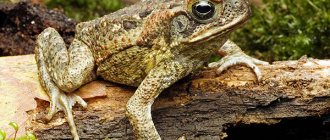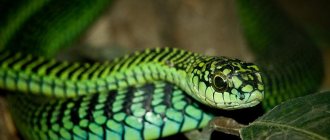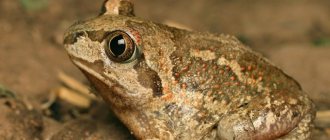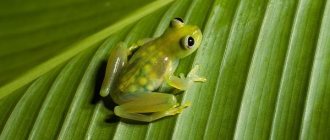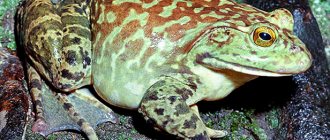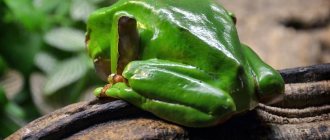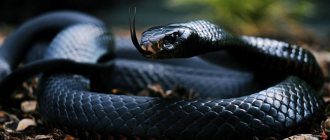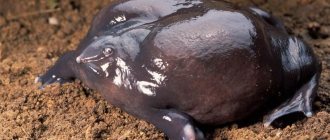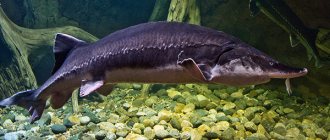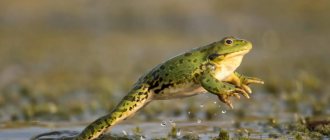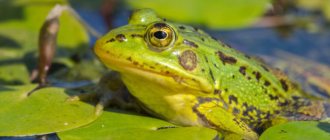Any living creature instinctively strives for self-preservation. To achieve this, animals use a variety of defense techniques. Some have a dense shell, others have sharp claws, and some defend themselves from enemies with deadly poisons. For example, this is exactly what the most poisonous frogs in the world do.
Similar substances are contained inside many amphibians, but most often the maximum that contact with them leads to is irritation of the skin or mucous membranes. However, when it comes to tropical animals, everything changes. If you see a frog painted in bright colors, you should stay as far away from it as possible.
Phyllomedusa bicolor
This large frog, often called the monkey frog, is very curious. Although its venom is not as dangerous as that of some other representatives of the frog world, most of us are unlikely to want to try its effects: the venom can cause unpleasant hallucinations or stomach problems. We say "most of us" because some tribes on the banks of the Amazon do deliberately use their poison to induce hallucinations.
Natural enemies of tree frogs
Photo: Animal tree frog
The tree frog, despite its poisonous mucus, has many natural enemies. They surround her on all sides. Birds, terrestrial predators, and larger amphibians prey on woodies. Among birds, the most dangerous enemies of tree frogs are representatives of corvids, ducks, and pheasants. They are also occasionally attacked by storks, ibises, and herons. They can pick up an animal on the fly.
On the ground and in the trees, they face no less danger. Foxes, otters, raccoons, wild boars, and smaller predators are not averse to eating them. The worst enemies are snakes. Even a tree can’t hide from them. Snakes deftly climb on them. Larger frogs and marsh turtles pose some danger to tree frogs. In some ways, the natural enemy of tree frogs is humans. Many animals die at the hands of humans during their capture or attempts at domestication.
If adult individuals have every chance to save their lives, run away and hide from predators, then tadpoles are practically defenseless. They die in large numbers from various water beetles, snakes, predatory fish and dragonflies. In general, almost all inhabitants of reservoirs are not averse to eating them. The offspring of frogs are saved from complete extinction by their numbers. At one time, the female lays about two thousand eggs.
Ranitomeya reticulatus
Native to Peru, this frog has a mild venom that can cause health problems in humans and can kill some animals. Like other poisonous frogs, these beautiful little creatures require special food to produce their poison. In this case, the “raw material” of poison for them is a poisonous ant. The frog stores poison in the skin glands and releases it as needed. Most often this happens in case of danger, when some predator is about to eat the frog.
How does the venom apparatus of amphibians work?
In the process of evolution, amphibians developed glands that secrete skin secretions. In toads, the suprascapular areas of the skin, which have the shape of ovals and protrude above the general surface of the skin, are especially important. These are suprascapular, or parotid glands, located on the sides of the head and secrete a poisonous secretion.
The suprascapular skin glands of toads have a structure typical of all amphibians - cellular, alveolar. Each such gland on average consists of 30-35 alveolar lobes. The alveolar lobule is a section of the gland containing a group of alveoli. The alveoli have their own excretory duct, which exits to the surface of the skin. When the toad is calm, it is usually closed by a plug of epithelial cells. The surface of the alveoli of the poisonous gland is lined on top with glandular cells that produce a poisonous secretion, which from them enters the cavity of the alveolar vesicle, where it remains until the need for defense arises. Fully formed amphibian venom glands contain up to 70 mg of poisonous secretion.
Unlike the suprascapular glands, ordinary small skin glands that secrete mucus have open excretory ducts. Through them, the mucous secretion reaches the surface of the skin, and, on the one hand, moisturizes it, and on the other, is a repellent.
The work of the suprascapular glands is simple. If, for example, a dog grabs a poisonous toad, it will immediately spit it out, and it’s good if it remains alive. When the gland is squeezed by the jaws, the poisonous secretion pushes out the epithelial plugs from the alveolar ducts and enters the dog’s oral cavity, and from there into the pharynx. Ultimately, severe general poisoning may occur.
The famous biologist-naturalist F. Talyzin described a case when a live toad was thrown into a cage with a hungry hawk. Naturally, the bird immediately grabbed it and began pecking. However, she suddenly recoiled sharply, hid in the corner of the cage, where she sat for some time, ruffled, and died a few minutes later.
For the toads themselves, the poison is not dangerous; on the contrary, it is a reliable means of protection. No one will dare to feast on such prey, except perhaps a ring-necked snake or a gigantic salamander - for them the toad’s poison does not pose a danger.
Poisonous tailless amphibians of Russia
In the European part of Russia and in the south, up to the Black Sea, as well as in the Crimea, you can meet amphibians from the spadefoot family (Pelobatidae). The pungent smell of the poisonous secretion of these amphibians resembles the smell of garlic. The venom of spadefoot toads is more toxic than that of, say, a green toad or a gray toad.
Common spadefoot spadefoot (Pelobates fuscus)
The habitat of the green toad (Bufo viridis) extends from North Africa to Asia and Siberia, passing through almost the entire territory of Europe. It is found everywhere near the southern borders of the European part of Russia and in Western Siberia. The green toad's skin has poisonous glands, but this is only dangerous for its enemies. The poison is not dangerous for other animals and humans.
Green toad (Bufo viridis)
In addition to the green toad, the gray or common toad (Bufo bufo) is widespread in Russia. It is dangerous for domestic animals - dogs, cats, and to a lesser extent for humans. The venom of this amphibian, accidentally applied to the mucous membranes of the eyes or mouth, causes inflammation and severe pain.
Common toad (Bufo bufo)
Another amphibian lives in the European part of Russia - the red-bellied firebird. It is widespread in Denmark and from southern Sweden to Austria, Hungary, Bulgaria, and Romania. It is dark gray on top, and the belly is bluish-black, with large bright orange spots (the so-called repellent coloration). Bright spots sharply highlight the toad against the green background of the grass and seem to warn that this frog is poisonous and should not be touched. In case of danger, if the toad does not have time to hide in the reservoir, it takes a characteristic pose: it arches its head upward, puts its front legs behind its back and puts its brightly colored spotted belly forward, thereby demonstrating its inviolability. And strangely enough, it usually works! But if this does not scare away a particularly persistent predator, the toad secretes a poisonous secretion, which is more poisonous than the secretion of spadefoots. The venom of the toad, like the venom of the spadefoot, has a pungent odor, causing watery eyes, sneezing, and pain when it comes into contact with the skin. More information about this amphibian can be found in this article.
Dendrobates azureus
This frog is really very cute, as can be seen from the photo. However, its beautiful and bright color does not bode well: its poison is enough to kill even the largest natural predator; there are cases where even people died from this poison. However, some brave people keep these creatures at home as pets. How is this possible, you ask? Fortunately, in captivity, frogs lose their poisonous properties, because they do not receive special food to produce poison, and they don’t need it, since no one will harm them in the aquarium. The frog retains its wonderful appearance, but loses its poison. This applies to all frogs on our list.
Appearance and features
Photo: Green tree frog
In terms of external qualities, the tree frog can be characterized as follows:
- suction disks on the paws. This feature unites all types of tree frogs. The suction cups create a vacuum, which allows the animal to climb trees, bushes, and leaves. At the same time, some individuals have a very underdeveloped ability to “stick” to a vertical surface. But here, too, nature has provided for everything - such frogs have a special structure of fingers on their limbs. It is with their help that the amphibian can cling to branches and plants;
- bright coloring. The color of the tree depends on the species. There are individuals with colors ranging from green to bright red with various stains and stripes. Most still have a camouflage color: green-brown. It helps the little frog easily get lost in a pile of leaves on the trees;
- relatively short body length. Usually it is about seven centimeters, only occasionally larger individuals are found;
- large, protruding eyes, with predominantly horizontal pupils. This eye structure allows amphibians to have a wide range of vision, hunt with ease, and safely jump from one branch to another;
- presence of a throat pouch in males. It is quite easy to distinguish between a female and a male. The most important sign is the presence of a throat pouch. Only males have it. When inflated, such a bag can make sounds. Moreover, males are always much smaller than females.
The tree frog is unique! Her body can withstand almost complete freezing. This is possible due to the presence of glycine in the body. It protects the body's cells from possible damage, loss of their qualities and vitality.
Phyllobates lugubris
The charming leaf climber is the least poisonous of its genus, although it still makes its victims bitterly regret that they tried to attack it. He is called "charming frog" only because of his appearance. If you want to find representatives of this species in the wild, you should go to Central America. It is unlikely that you will have to look for it for a long time, since such poisonous creatures are usually not going to hide from someone.
Social structure and reproduction
Photo: Tree frog
The breeding season for woodworts begins at the end of March. Lasts until mid-June. However, the season and its duration depend on the habitat of the frogs. In the mountains, the mating season begins about a month later. During the mating season, members of the family behave differently, depending on the species. However, one thing is the same for everyone - males attract females with the help of a throat pouch, which makes a special sound. The sound of the sac is different for each type of tree frog, so the “right” frogs respond to it.
If tree frogs spend most of their free time in the trees, then to mate they descend to the ground and go to the water. It is in the water that the eggs are laid, where the male fertilizes them. Only certain species of woodies mate on the ground. In this case, the eggs are hidden in the leaves or carried on themselves until the tadpoles hatch. At one time, female frogs are capable of laying more than two thousand eggs.
After ten days, the first tadpoles emerge from the eggs. The ripening period may be shorter. In some species of tree frogs it lasts only a few days. Over the course of fifty to one hundred days, the tadpoles gradually become similar to adult trees. Full maturation occurs only in the second or third year of life. The overall lifespan of tree frogs also varies. Some species live only three years, others about nine years. In captivity, such animals live longer - up to twenty years.
Ranitomeya variabilis
These beautiful creatures live in the tropical forests of Ecuador and Peru and are one of the most poisonous members of the Ranitomeya
. The poison of one frog can be enough to kill 5 people! Although the frog looks very cute, it should not be touched under any circumstances. Even if you are lucky enough to visit the forests of Ecuador or Peru, you should not be afraid to encounter a frog. She will never attack first.
Where does the tree frog live?
Photo: Tree frog tree frog
The natural habitat of woodchucks is not so small. They prefer to live in a temperate climate zone. Mainly inhabit Asia and Europe. Their habitat includes northwest Africa, Japan, the Netherlands, Romania, Belarus, Lithuania, Ukraine, Poland, Russia, North and South America. In Russia, such frogs can be found only in the central part. Their family on Russian territory is represented by only two species - ordinary and Far Eastern.
A huge number of varieties of wood can be found in Tunisia, China, Korea, Turkey and Australia. The Caribbean islands are also inhabited by similar amphibians in large numbers. Where this species was not represented, it was introduced artificially. For example, tree frogs appeared in this way in New Zealand, Guam, New Caledonia, and Vanuatu. Some representatives, in particular the redwood tree, were found in small quantities in the jungles of Costa Rica and Panama.
Today, the tree frog can become an inhabitant of any home. These animals are sold in many large pet stores. However, keeping such amphibians at home requires considerable investment, special knowledge and skills. It is important to maintain a comfortable temperature - about 23 degrees, provide the required humidity (at least 70%), and equip the terrarium with driftwood, twigs, and plants. If these conditions are not met, the animal may die.
For life, woodworts choose regions with temperate climates, humid mixed and tropical forests. Only certain species prefer to settle directly in lakes and ponds. In this case, they give preference to reservoirs, lakes, ponds with dense vegetation, where many insects live.
Epipedobates tricolor
These frogs are very small, but are one of the most deadly amphibians. They can kill not only large animals, but also humans, so no one would think of playing with them. Frogs are endangered, so they can rarely be found even in their homeland - in the forests of Ecuador. To save these frogs and increase their numbers, researchers are trying to breed them in captivity. Preserving them is also important from a medical point of view: the poison of these frogs is 200 times stronger than morphine and is an excellent pain reliever.
Striped leaf climber
In the poison dart frog family, there is a genus with a similar name – leaf frogs. The striped leaf climber is predominantly black, but has a bright stripe on its back. In some individuals it is yellow. A wide stripe of bright orange, red or gold runs along the frog's face and all the way to the base of the thigh. There is also a white line on their bodies that extends beyond the shoulder.
The feet of striped leaf climbers are blue-green due to many small specks. Also on the underside, light spots of blue and green colors create a marble pattern. Striped leaf climbers are distinguished by their very small size. Adult males grow to a maximum of 26 mm, while females can be 31 mm.
You can meet such frogs in a bay of the Pacific Ocean called Golfo Dulce, or in the humid forests of Costa Rica. Striped leaf climbers live in high terrain, up to 500 m above sea level. They hide between tree roots and in rocky crevices, leading a predominantly terrestrial lifestyle.
Phyllobates terribilis
This extremely poisonous frog lives in Colombia. Despite their eye-catching appearance, these creatures are not the type to play with: their bright colors warn of danger. In fact, these frogs are so poisonous that a person can die just by touching them, hence the name. Dire leaf climbers do not use venom to kill their prey, but only to protect themselves from predators. Therefore, if you see frogs in the forest, but do not try to touch them, they will not cause you any harm.
What does a tree frog eat?
Photo: Poison tree frog
Absolutely all amphibians are carnivores. Tree frogs are no exception. The diet depends on the type of individual and its size. They usually eat small insects. The diet includes flies, ground beetles, cockroaches, crickets, and mosquitoes. Woodworts also feed on some invertebrates: small woodlice, slugs, and earthworms. Only occasionally can frogs feast on mice and young lizards.
Like most representatives of the order of tailless amphibians, cases of cannibalism occur among some species of woodies. This is usually typical for large adults that can eat the young. Today, tree frogs often become pets. However, this does not change their diet much. The pet owner must provide an adequate supply of small insects. For ease of feeding, you can purchase special tweezers.
Woodworts eat insects and other food in the warm season. For hunting, they choose secluded places and camouflage themselves among the greenery. The tree frog can wait for prey for several hours absolutely motionless. These amphibians usually hunt at dusk, at night. They catch small insects with a very long tongue, and help themselves to eat and swallow larger prey with their front paws.
In winter, frogs do not hunt. They first find shelter for themselves and hibernate. During hibernation, the body's metabolism slows down significantly. Tree frogs survive solely on their own internal reserves. At the same time, the animal can withstand any temperature. The woodies return to their usual habitat around mid-March.
Spotted dart frog
The spotted poison dart frog is amazingly beautiful. Moreover, beauty is due to multi-colored skin.
It is important to note that the skin of the spotted poison dart frog is poisonous. It is interesting to note that the poison has a special effect on parrots. Amazon tribes noticed that the color of parrot feathers changes under the influence of the venom of the spotted dart frog.
Yeah / Rhinella marina
The poisonous tropical toad takes an honorable second place among all toads, but its toxicity makes it a leader among poisonous amphibians.
The largest specimen reached a size of 24 cm, although on average the toad grows from 15 to 17 cm. It comes from Central America, but to fight insects they were brought to Australia, from where Aga settled on the islands of Oceania.
The strongest poison affects the heart and affects the nervous system. The most dangerous thing is that the green toad can shoot poison over a distance.
1
Chiriquita toad
In Panama and Costa Rica you can find one of the most poisonous toads, which has a bright color and does not grow more than 5 cm. Note that males are usually smaller and reach a length of only 3 cm.
When poison gets on the skin, the channels of nerve endings are blocked, and the person experiences a loss of coordination of movement, the person begins to have convulsions, and the sad result of all this can be complete paralysis.
Unfortunately, an antidote has not yet been invented, but it is necessary to carry out general detoxification in time, and then irreparable consequences for the health of the human body can be avoided.
7
